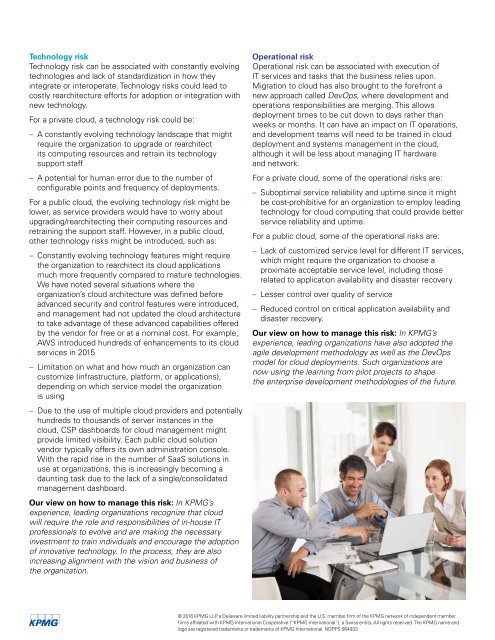How to manage five key cloud computing risks
1UxxcIg
1UxxcIg
You also want an ePaper? Increase the reach of your titles
YUMPU automatically turns print PDFs into web optimized ePapers that Google loves.
Technology risk<br />
Technology risk can be associated with constantly evolving<br />
technologies and lack of standardization in how they<br />
integrate or interoperate. Technology <strong>risks</strong> could lead <strong>to</strong><br />
costly rearchitecture efforts for adoption or integration with<br />
new technology.<br />
For a private <strong>cloud</strong>, a technology risk could be:<br />
––<br />
A constantly evolving technology landscape that might<br />
require the organization <strong>to</strong> upgrade or rearchitect<br />
its <strong>computing</strong> resources and retrain its technology<br />
support staff<br />
––<br />
A potential for human error due <strong>to</strong> the number of<br />
configurable points and frequency of deployments.<br />
For a public <strong>cloud</strong>, the evolving technology risk might be<br />
lower, as service providers would have <strong>to</strong> worry about<br />
upgrading/rearchitecting their <strong>computing</strong> resources and<br />
retraining the support staff. <strong>How</strong>ever, in a public <strong>cloud</strong>,<br />
other technology <strong>risks</strong> might be introduced, such as:<br />
––<br />
Constantly evolving technology features might require<br />
the organization <strong>to</strong> rearchitect its <strong>cloud</strong> applications<br />
much more frequently compared <strong>to</strong> mature technologies.<br />
We have noted several situations where the<br />
organization’s <strong>cloud</strong> architecture was defined before<br />
advanced security and control features were introduced,<br />
and <strong>manage</strong>ment had not updated the <strong>cloud</strong> architecture<br />
<strong>to</strong> take advantage of these advanced capabilities offered<br />
by the vendor for free or at a nominal cost. For example,<br />
AWS introduced hundreds of enhancements <strong>to</strong> its <strong>cloud</strong><br />
services in 2015<br />
––<br />
Limitation on what and how much an organization can<br />
cus<strong>to</strong>mize (infrastructure, platform, or applications),<br />
depending on which service model the organization<br />
is using<br />
––<br />
Due <strong>to</strong> the use of multiple <strong>cloud</strong> providers and potentially<br />
hundreds <strong>to</strong> thousands of server instances in the<br />
<strong>cloud</strong>, CSP dashboards for <strong>cloud</strong> <strong>manage</strong>ment might<br />
provide limited visibility. Each public <strong>cloud</strong> solution<br />
vendor typically offers its own administration console.<br />
With the rapid rise in the number of SaaS solutions in<br />
use at organizations, this is increasingly becoming a<br />
daunting task due <strong>to</strong> the lack of a single/consolidated<br />
<strong>manage</strong>ment dashboard.<br />
Our view on how <strong>to</strong> <strong>manage</strong> this risk: In KPMG’s<br />
experience, leading organizations recognize that <strong>cloud</strong><br />
will require the role and responsibilities of in-house IT<br />
professionals <strong>to</strong> evolve and are making the necessary<br />
investment <strong>to</strong> train individuals and encourage the adoption<br />
of innovative technology. In the process, they are also<br />
increasing alignment with the vision and business of<br />
the organization.<br />
Operational risk<br />
Operational risk can be associated with execution of<br />
IT services and tasks that the business relies upon.<br />
Migration <strong>to</strong> <strong>cloud</strong> has also brought <strong>to</strong> the forefront a<br />
new approach called DevOps, where development and<br />
operations responsibilities are merging. This allows<br />
deployment times <strong>to</strong> be cut down <strong>to</strong> days rather than<br />
weeks or months. It can have an impact on IT operations,<br />
and development teams will need <strong>to</strong> be trained in <strong>cloud</strong><br />
deployment and systems <strong>manage</strong>ment in the <strong>cloud</strong>,<br />
although it will be less about managing IT hardware<br />
and network.<br />
For a private <strong>cloud</strong>, some of the operational <strong>risks</strong> are:<br />
––<br />
Suboptimal service reliability and uptime since it might<br />
be cost-prohibitive for an organization <strong>to</strong> employ leading<br />
technology for <strong>cloud</strong> <strong>computing</strong> that could provide better<br />
service reliability and uptime.<br />
For a public <strong>cloud</strong>, some of the operational <strong>risks</strong> are:<br />
––<br />
Lack of cus<strong>to</strong>mized service level for different IT services,<br />
which might require the organization <strong>to</strong> choose a<br />
proximate acceptable service level, including those<br />
related <strong>to</strong> application availability and disaster recovery<br />
––<br />
Lesser control over quality of service<br />
––<br />
Reduced control on critical application availability and<br />
disaster recovery.<br />
Our view on how <strong>to</strong> <strong>manage</strong> this risk: In KPMG’s<br />
experience, leading organizations have also adopted the<br />
agile development methodology as well as the DevOps<br />
model for <strong>cloud</strong> deployments. Such organizations are<br />
now using the learning from pilot projects <strong>to</strong> shape<br />
the enterprise development methodologies of the future.<br />
© 2016 KPMG LLP, a Delaware limited liability partnership and the U.S. member firm of the KPMG network of independent member<br />
firms affiliated with KPMG International Cooperative (“KPMG International”), a Swiss entity. All rights reserved. The KPMG name and<br />
logo are registered trademarks or trademarks of KPMG International. NDPPS 564933


